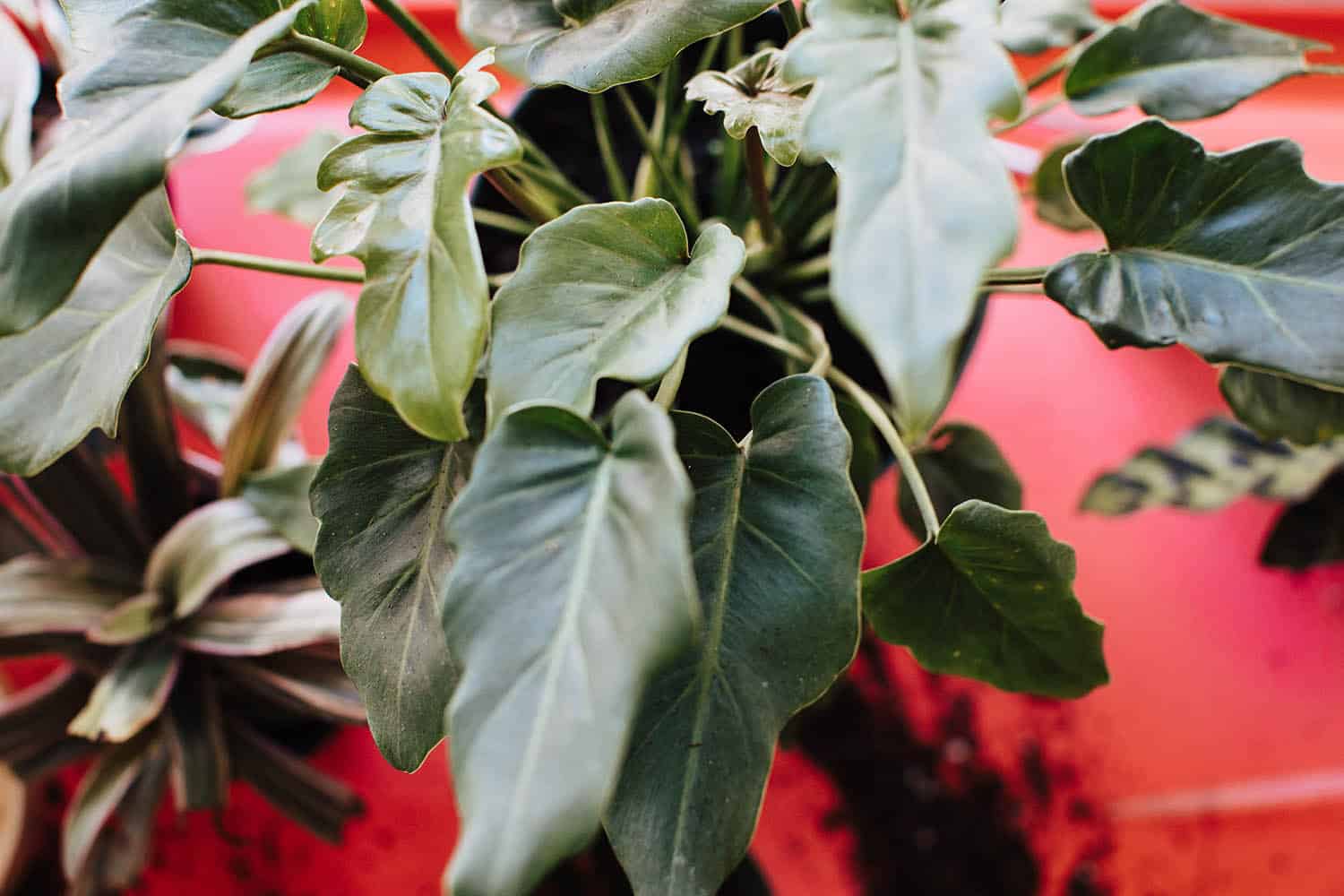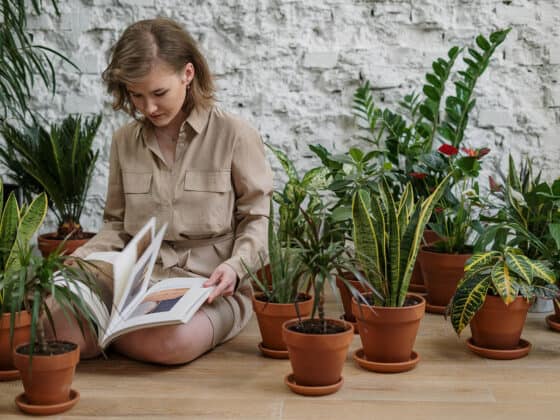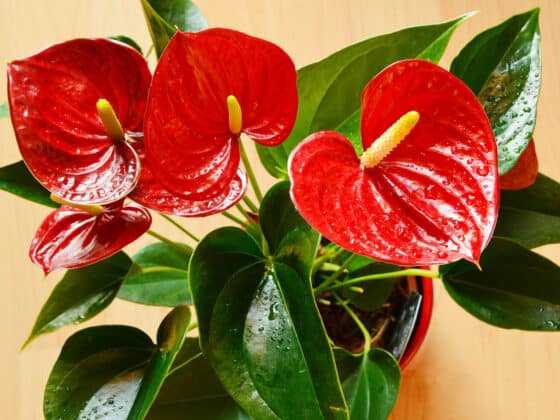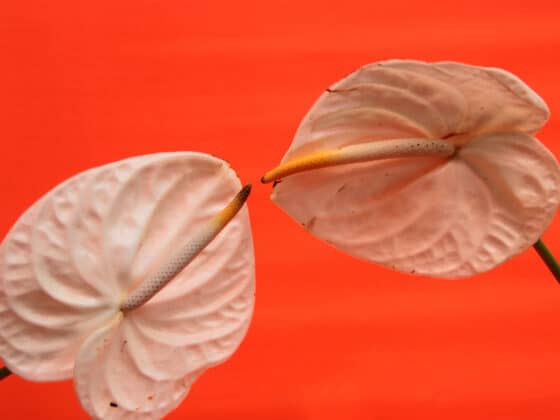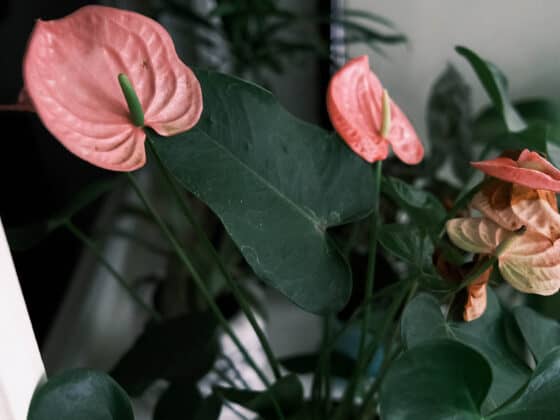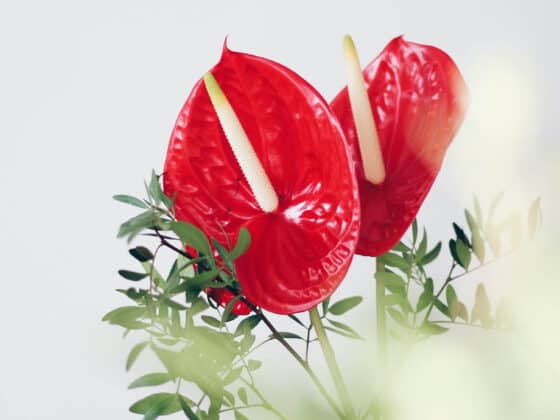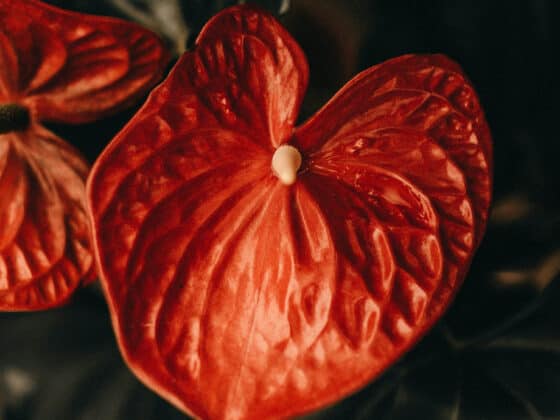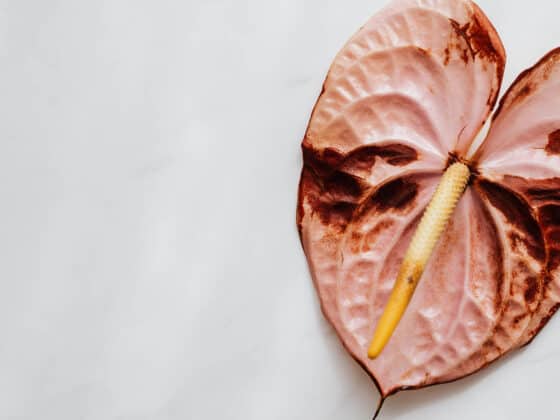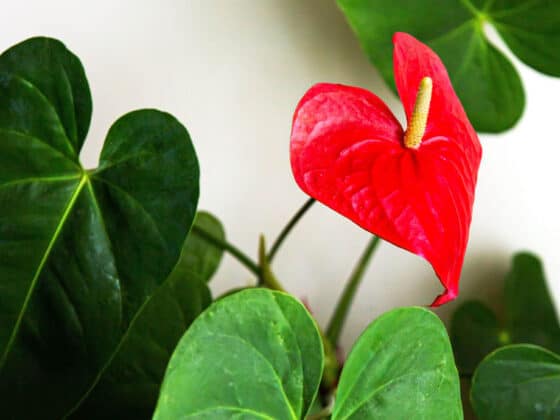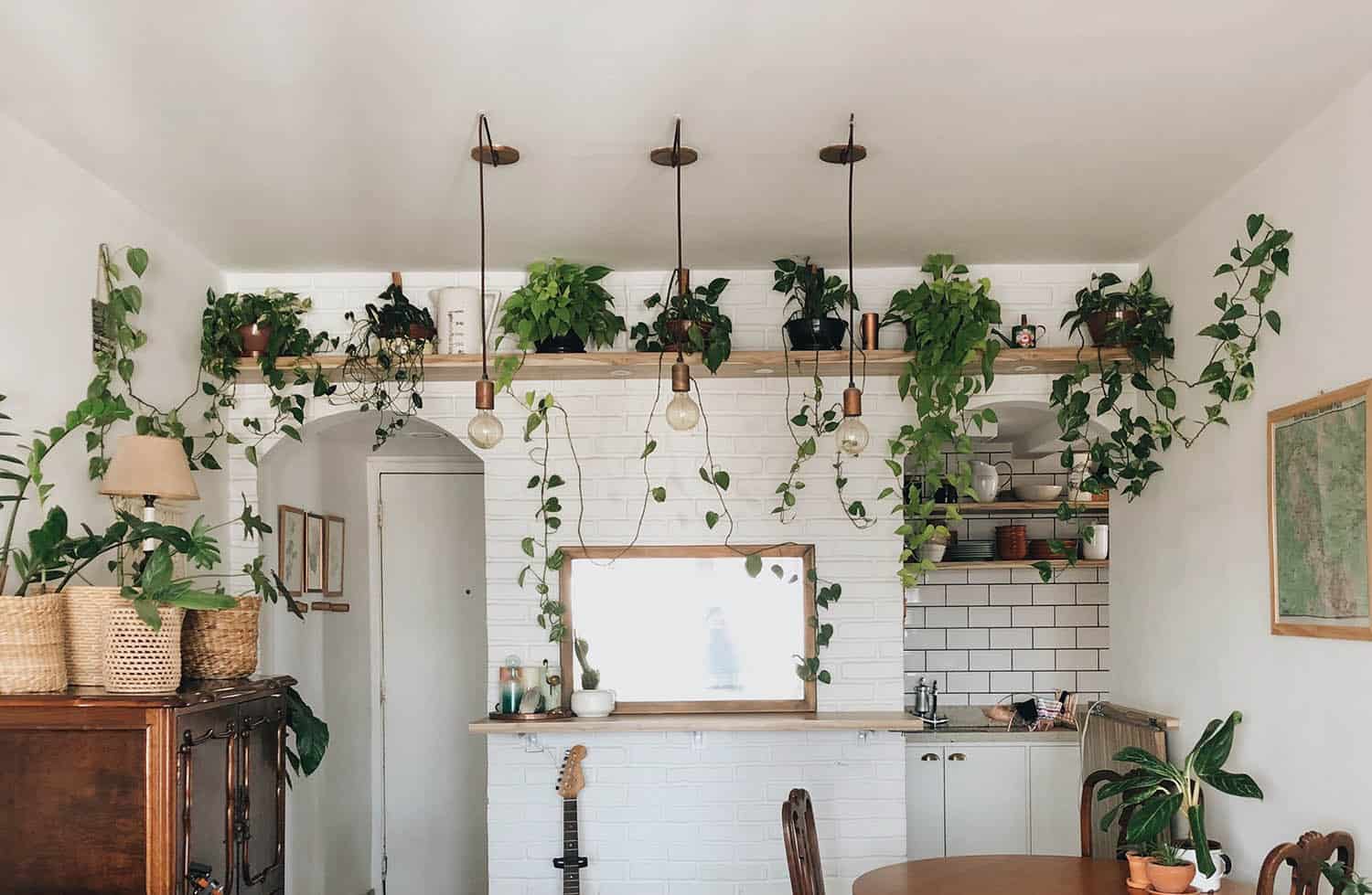Your Flamingo Flower usually lives up to its name, standing tall and showing off its colors. Lately, though, it’s begun sagging and slouching as though it’s lost its zest for life. We’ll explain how to fix the most common issues that cause Anthuriums to droop.
The number one way to stop your plant from wilting is to ensure you’re watering it correctly – not too much, and not too little. You should be watering your Anthurium thoroughly, but only when the top few inches of soil have dried out. And make sure that both pot and potting mix allow for good drainage.
Insufficient heat or humidity can also cause drooping in Anthuriums – these plants are adapted to tropical rainforests, and they don’t thrive in environments that are too cold or too dry. It might also be suffering from a pest infestation. Sap-sucking critters like mites and aphids can cause plants to sag without other obvious signs of damage.
Why Do Unhappy Anthuriums Wilt?
A healthy anthurium has a dashing appearance, with bright red flowers rising up above its lush foliage. But when something’s off with their growing conditions, these plants can look remarkably mopey, with their big leaves drooping down like Eeyore’s head.
Before we get into specific fixes, it’s worth taking a moment to talk about what’s actually happening when a plant is wilting. Why does your Anthurium respond to distress by slouching and sagging?
It all comes down to the way that water moves through a plant’s body. Plants don’t have skeletons, so they rely on the water pressure within their cells to keep their stalks upright and their flesh firm.
When your Anthurium isn’t taking in enough water to replace the evaporation from its leaves, it begins to lose the internal pressure that lets it stand tall. Its tissues loosen, causing leaves to crumple and stems to droop.
How To Keep Anthuriums Properly Watered
Okay, so if your Anthurium is sagging because its cells don’t have enough water, you should be able to fix it by giving it more to drink, right? Actually, the answer is a little more complicated.
While underwatering can definitely lead to wilting, drooping in Anthuriums can just as easily be caused by overwatering – and in fact, this is actually the more common cause.
In nature, Anthuriums grow along the trunks of trees or in rich, loose humus – not in swamps or bogs. Their roots need to breathe, and waterlogged soil doesn’t have enough oxygen for them to function properly.
Worse, soggy soil can lead to the rampant growth of bacteria or fungi, leading to the nightmare of any houseplant grower: root rot. This condition can kill off huge chunks of a plant’s root system and kill the plant if left untreated.
Dysfunction in the roots has the same effect as underwatering: not enough water getting to the plant’s tissues. It doesn’t matter how much you give your Anthurium to drink if its roots can’t absorb it.
You need to shoot for the sweet spot between too much water and not enough. The best way to do this is to monitor the soil in your Anthurium’s pot, watering only when it’s dried out enough.
A simple test is to stick your finger into the soil up to the first knuckle or two. If it still feels damp, it’s not yet time to water. And if you prefer a more scientific method (or not to stick your fingers into dirt), you can always make the small investment into a moisture meter.
When you do refresh your Anthurium, be thorough! Keep pouring until you see water emerging from the drainage holes at the base of the pot. That’s another thing: your Anthurium’s container should always have good drainage. Never put it in a pot without holes at the base.
Use a light potting soil – orchid mix often works well – and if necessary, supplement it with additives like compost, perlite, and bark to keep it loose. All of these things will work to facilitate excellent drainage – which will, in turn, keep your Anthurium at its happiest.
Signs Of Overwatering
So how can you tell whether a drooping plant is overwatered or underwatered? Here are some other indicators that your Anthurium may be getting too much to drink:
Damp soil. Hopefully, this one is obvious – if the plant is wilting even though the soil is moist, it’s probably because it’s too moist!
Yellowing leaves. If your Anthurium’s foliage is turning yellow all over, and new leaves are dropping off, this can often indicate overwatering.
Edema. Brown or pale spots can appear on the leaves when the plant’s tissues become swollen from overwatering and rupture.
Visible mold or fungus. This can be a warning sign that root rot is underway, in which case you should immediately uproot it and trim any infected roots.
Foul-smelling soil. Another possible indicator of root rot.
Signs Of Underwatering
On the other hand, if you see the following signs, it’s more likely your Anthurium is underwatered:
Soil pulling back. When the soil in your plant’s container is shrinking away from the edges, it’s an indicator of persistent dryness.
Dry, crispy leaves or stems. An underwatered plant will often have a texture closer to dead leaves than living ones, particularly where you see browning at the edges.
Slowed growth. If your Anthurium hasn’t been growing as vigorously, it may not be getting enough water.
Temperature-Related Wilting In Anthuriums
Another reason your plant might be sagging is that it’s too chilly. Anthuriums can withstand a decent range of indoor temperatures, but below 50 degrees Fahrenheit they’ll suffer, and wilting can be one early symptom.
They also like the temperature to stay consistent. If the temperature in your home drops sharply at night, consider placing your Anthurium in a warmer part of your house after sundown. This also means you keep it away from doors to the outside or windows that you frequently open or close – avoid anywhere that’s too drafty.
Note that, as with water, too much can be as bad as too little! Though they’re tropical plants, Anthuriums may also sag if they’re kept in conditions hotter than 90 degrees Fahrenheit.
Anthuriums and Humidity
Although Flamingo Flowers don’t do well with soggy roots, they do like moist air. Lack of humidity can be another cause of drooping. If you’re keeping your Anthurium near a heater or a dehumidifier, the air may be too dry for its taste.
You can use a hygrometer to check the humidity levels in various rooms of your home. Anthuriums and other tropical plants prefer humidity levels of at least 50%. For that reason, they often do best in well-lit bathrooms or kitchens.
Misting the plant frequently with a spray bottle is one way to ensure it has enough moisture. However, you should monitor extra carefully for fungal infections if you use this method.
Another handy option is a humidity tray. Fill a shallow container with smooth rocks, beads, or clay marbles, and add some water to the base. Then place your Anthurium’s pot on top. The filler materials will keep the water from soaking the roots directly, but the evaporation will create a nice moist atmosphere for your Anthurium.
But if you live in an area with very low humidity, the best option is to add a humidifier to the area surrounding your plants. Humidifiers will make the biggest difference in humidity levels and will benefit both you and your houseplants. We recommend this Humidifier for most beginner houseplant owners. To see why, or to find out more about our other favorites, click here to read about the best humidifiers for indoor plants.
Pest Problems
It’s easy to tell when something is chewing holes in your plant’s leaves, but there are a number of sneakier insects that feed by sucking the juices out of the stems.
These pests can mimic the symptoms of underwatering because the insects are draining the plant faster than it can replenish itself. If your Anthurium is wilting, it’s worth checking for signs of infestation.
The most common culprits are spider mites and thrips. They’re both tricky to spot because they just look like tiny black dots. Spider mites may also wrap leaves in the telltale webbing that gives them their name.
If you’re unsure whether your Anthurium is infested, you can hold a piece of blank paper under the leaves and shake them. If lots of little black specks fall onto the surface, they’re probably bugs.
You can spray the plant with a solution of neem oil or diluted dish soap to kill these pests. If using neem oil, test it on a small section of the plant first to make sure it’s not too harsh. If you go with dish soap, avoid anything with bleach or degreaser additives.
Putting It All Together
There are lots of possible causes for a droopy Anthurium, so you’ll need to do a little diagnostic work. Check for watering issues first, because if there’s any chance of root rot, it should be addressed right away. Then look for signs of pest infestation, dryness, and temperature problems.
Moving forward, monitor your Anthurium’s health closely and make sure you’re giving it the conditions it needs to thrive. With proper care, it will keep its gorgeous blooms held high.






